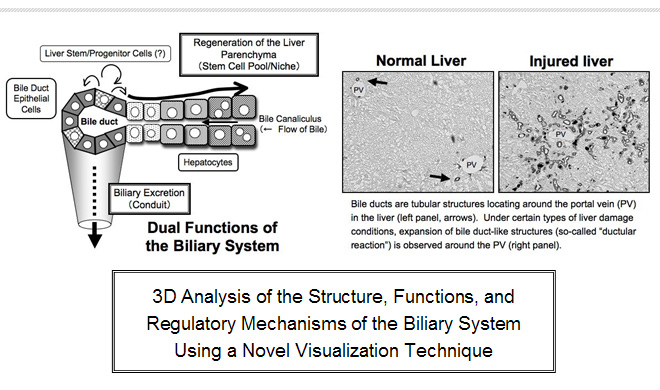|
HOME > Proposed research projects > 2012-2013: Proposed research projects 18
 2012-2013: Proposed research project 183D analysis on the dynamic behavior of the biliary system under normal and liver injury conditions using a novel visualization technique
Purpose of the Research ProjectThe liver is an essential organ for life with multiple important functions, among which is the production of bile. The bile produced in hepatocytes, the liver parenchymal cells, is collected in bile canaliculi, which connect to epithelial tubular structures called bile ducts. Bile ducts in the liver form tree-like structures with many small branches, and the trunk of this biliary tree leads to the duodenum, where the bile is excreted. Thus, bile ducts serve primarily as the conduit for biliary excretion. On the other hand, it has become evident in recent years that the biliary system also plays an important role for liver regeneration. Under severe liver damage conditions, expansion of bile duct-like structures is often observed around the portal vein, known as the ductular reaction. It is considered that these structures contain the stem/progenitor cell population that is involved in regeneration of the damaged liver parenchyma by differentiating to hepatocytes. Thus, the biliary system can also be recognized as the pool and/or niche for the liver stem/progenitor cells. In this project, we try to understand how the structure and functions of the biliary system change according to various liver damage conditions and the underlying cellular and molecular mechanisms regulating its dynamic behavior. Content of the Research ProjectAs the biliary system forms a tree-like structure inside the liver, it is difficult to understand its whole aspect and true colors based on generic 2D analyses using tissue sections. To circumvent this problem, we have developed a novel technique that can visualize the 3D structure of the whole biliary tree within mouse liver samples. Based on this original method, we are planning to analyze the tubular structure (lumen) formation, cellular characteristics, and stem/progenitor cell activity of the biliary system in various mouse liver disease models. With particular focus on its interaction with other liver component cells and the responsible intercellular signal transduction systems, we’ll try to unveil the cellular and melucular basis for its regulation. Expected Research Achievements and Scientific SignificanceOur current project based on the novel 3D visualization method is expected to lead to construction and establishment of a whole new picture of the biliary system and the precise understanding of its dynamic behavior. This will not only lead to significant progress in the field of liver biology but also serve as a paradigm for future studies in the field of "Tubulology" in general. Our study will also contribute to better understanding of the mechanisms of liver and biliary diseases and development of therapies to conquer them.
|








